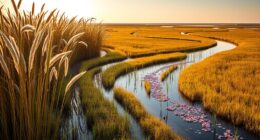Connecting wildlife conservation with human well-being is crucial for fostering healthy ecosystems and preventing disease outbreaks. By supporting natural wildlife corridors, you help reduce animal stress and pressure, which lowers the risk of zoonotic diseases jumping to humans. Protecting habitats maintains biodiversity and ecological balance, essential for services like pollination and water quality. Embracing a One Health approach means understanding how protecting wildlife benefits your health too—keep exploring to learn more about this essential connection.
Key Takeaways
- Wildlife corridors support healthy animal populations, reducing disease transmission risks that can affect both ecosystems and human health.
- Connecting habitats minimizes zoonotic spillover by decreasing animal stress and overcrowding, preventing outbreaks like Ebola and COVID-19.
- Conserving biodiversity and genetic diversity enhances ecosystem resilience, lowering the emergence of new health threats to humans.
- Integrating conservation with community engagement promotes sustainable practices, reducing environmental health risks and supporting public well-being.
- The One Health approach links wildlife conservation, ecosystem health, and human safety, emphasizing holistic strategies for sustainable health outcomes.

Have you ever wondered how protecting wildlife directly benefits your health and well-being? It’s more interconnected than you might think. One key element in this relationship is the creation and preservation of wildlife corridors. These natural pathways allow animals to move safely between habitats, reducing their stress and promoting healthier populations. When animals can migrate freely, they’re less likely to become overcrowded or fragmented, which diminishes the chances of disease transmission. Without such corridors, animals are forced into smaller, confined areas where diseases can spread rapidly, increasing the risk of outbreaks that could jump to humans.
Wildlife corridors serve as crucial links that promote biodiversity and ecological stability. By maintaining these pathways, we reduce the likelihood of zoonotic diseases—those transmitted from animals to humans—spreading unchecked. When animals are forced into close quarters because their habitats are fragmented, it creates an ideal environment for pathogens to thrive and evolve. This can lead to outbreaks of illnesses like Ebola, COVID-19, or other emerging infectious diseases, which often originate from wildlife. Protecting these corridors isn’t just about conservation; it’s a public health measure that helps curb disease transmission at its source, ultimately safeguarding your health.
Furthermore, healthy wildlife populations contribute to a balanced ecosystem that supports human well-being. They help control pests, pollinate plants, and maintain water quality—all essential services for our daily lives. When ecosystems are disrupted due to habitat loss or fragmentation, these natural benefits diminish, and humans may face increased exposure to pests or reduced crop yields. By conserving wildlife corridors, you’re supporting these natural processes, which in turn helps prevent the emergence of new health threats linked to ecological imbalance. Additionally, habitat connectivity plays a vital role in maintaining genetic diversity within animal populations, reducing their vulnerability to disease outbreaks and environmental changes.
In addition, protecting wildlife and their habitats fosters a sense of connection and responsibility. It encourages communities to adopt sustainable practices that benefit both nature and public health. When you support conservation efforts that prioritize wildlife corridors, you’re actively reducing the risk of disease spillovers from animals to humans. This holistic approach, known as One Health, emphasizes that human health is intertwined with the health of animals and ecosystems. Recognizing the importance of solar energy solutions in reducing reliance on fossil fuels and lowering pollution further complements these conservation efforts, creating a more sustainable and resilient environment. By viewing conservation as a preventive measure against disease transmission, you contribute to a safer, healthier world for everyone. Protecting wildlife isn’t just about saving animals; it’s about creating a resilient environment where humans can thrive without the constant threat of emerging diseases.
Frequently Asked Questions
How Does One Health Influence Global Economic Policies?
You see, One Health influences global economic policies by emphasizing the need for policy integration across sectors. When you consider how healthy ecosystems and humans are interconnected, you realize that economic stability depends on managing risks like pandemics and environmental degradation. By adopting One Health principles, policymakers can better allocate resources, create sustainable strategies, and reduce costs, ensuring more resilient economies worldwide.
What Are the Biggest Challenges in Implementing One Health Initiatives?
Imagine a tightrope walker balancing between two worlds—your biggest challenge in One Health initiatives is maintaining that balance. Interdisciplinary collaboration is essential but often difficult to coordinate, as different sectors have varied priorities. Funding challenges also threaten progress, making it hard to sustain long-term efforts. Without overcoming these obstacles, your ability to protect both human health and wildlife becomes a fragile act, risking future setbacks in global health.
How Can Individuals Contribute to Wildlife Conservation Efforts?
You can contribute to wildlife conservation by engaging with your community and promoting sustainable practices. Volunteer for local conservation projects, educate others about the importance of protecting wildlife, and support policies that prioritize habitat preservation. Reducing your ecological footprint, such as minimizing waste and conserving water, also helps. Your active involvement and advocacy can make a real difference in safeguarding ecosystems and ensuring wildlife thrives for generations to come.
What Role Do Technology and Innovation Play in One Health?
Ever wondered how technology shapes our health and environment? You see, predictive analytics helps anticipate disease outbreaks, allowing early interventions that protect both humans and wildlife. Biotechnology advancements enable scientists to develop vaccines and improve conservation efforts. These innovations are essential; they connect human well-being with wildlife health, creating a more sustainable future. By embracing such technology, you help bridge the gap between health and conservation efforts worldwide.
How Does Climate Change Impact the Effectiveness of One Health Strategies?
Climate change challenges the effectiveness of One Health strategies by disrupting ecological resilience and complicating climate adaptation efforts. You might find that rising temperatures and extreme weather events threaten wildlife, agriculture, and human health, reducing the ability to prevent disease spread or maintain ecosystem balance. These changes require you to adapt strategies, strengthen ecological resilience, and develop innovative approaches to guarantee that One Health initiatives remain successful amid a changing climate.
Conclusion
By embracing the One Health approach, you can protect precious wildlife and promote personal prosperity. When you prioritize preservation and partnership, you pave the path for healthier habitats and happier humans. Remember, your choices can create a cycle of compassion and conservation, connecting communities with creatures and caring for both. So, step forward, support sustainable solutions, and see how your efforts spark a symphony of safety, species, and self — a truly transformative tapestry of well-being.









